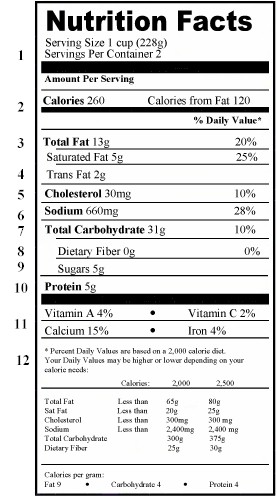BREAKING DOWN THE NUTRITION FACTS LABEL
Reading Nutrition Facts labels can be difficult, especially if you don’t know what to look for. The Nutrition Facts Label gives a lot of information but the key is to know how to use it to help you make healthy food choices.
1. SERVING SIZE
This is the food’s recommended serving size. It can include a weight measurement (for example: one cup) or a number of pieces of food (12 pretzels).
Serving per Container
This is the suggested number of servings. For example, if a food has four servings per container and you eat half of the bag, you would be eating two servings. It is always important to look at these numbers because you may be eating more than you think!
2. CALORIES
This is the amount of calories per serving (using the correct serving size). Eating too many calories promotes weight gain. Calorie needs are based on individual needs.
Calories from Fat
These are calories solely from fat. Choose foods with less than 30% of calories coming from fat.
3. TOTAL FAT
This is the total fat per one serving in grams and in % Daily Value. Choose foods with less fat.
Saturated Fat
This is fat from animal and dairy products and tropical oils measured in grams. A diet high in saturated fat is a risk factor for coronary artery disease. Choose foods with 2 grams or less saturated fat.
- Labels may also list monounsaturated and polyunsaturated fats. These are unsaturated fats that may help protect your heart, however all fats should be used in moderation.
4. TRANS FATS
Trans Fats are now listed on every nutrition label. Trans fats are formed by chemically changing the oil called hydrogenation, which increases product shelf life and flavor. A diet high in Trans fats has shown to increase cholesterol levels, which increases risk of heart disease. If a food has the words “partially hydrogenated oil” on the label it contains Trans fats. It is recommended by the American Heart Association to avoid Trans fats.
5. CHOLESTEROL
This is another form of fat measured in milligrams. Too much dietary cholesterol is another risk factor for heart disease. Cholesterol is found in organ meats, dairy products, shrimp, and egg yolks. Limit intake to 300 milligrams daily.
- Use foods with 5% or less saturated fats and cholesterol and avoid those with over 20% of the daily value.
6. SODIUM
This is a nutrient that helps regulate blood pressure and fluid balance measured in milligrams, which most people consider “salt”.
Research has suggested that a high sodium intake can be related to high blood pressure. The RDA for sodium is 2300 milligrams per day. For example, one teaspoon of table salt has ~2000 milligrams of sodium.
7. TOTAL CARBOHYDRATE
This is the amount of total carbohydrate per serving measured in grams. Carbohydrates are primarily found in starches, vegetables, fruits, sweets and milk. Carbohydrate counting is used in diabetes meal planning.
8. DIETARY FIBER
This is the amount of indigestible bulk from plant foods such as fruits, vegetables, whole grains, oats, nuts and seeds and is measured in grams. Foods high in fiber are shown to be beneficial for weight control, diabetes, high cholesterol and some forms of cancer. Foods with five grams of fiber or more are considered “high fiber” foods.
9. SUGARS
These are part of the Total Carbohydrate content and are measured in grams. These contain sugars from natural and artificial sources. There are no daily reference values for sugars.
10. PROTEIN
This is the amount of total protein the food contains measured in grams. Protein contains amino acids found in meat, poultry, fish, dairy, eggs, nuts, beans, grains and some vegetables. Protein needs are individualized based on height, weight, age and physical activity level.
11. VITAMINS AND MINERALS
These are micronutrients measured in percentages. The goal is to consume 100% of each of these nutrients daily to prevent nutrition related diseases.
12. PERCENT DAILY VALUES
The Percent Daily Value shows the amount of each of the nutrients listed above needed daily in a 2000 and a 2500-calorie diet. This is the percentage of each nutrient recommended to meet the needs of the average person each day and is measured in grams and milligrams depending on the nutrient. The Percent Daily Values are listed on the top half of the food label and are based on recommendations for a 2,000 calorie diet, not a 2,500 calorie diet. Five percent or less of the % Daily Value is considered low, whereas 20% or more is considered high.
INGREDIENT LIST
The ingredient list is another part of the Nutrition Label. Items are listed by weight in descending order of predominance. Spices, artificial coloring and flavors are listed on the ingredient list.








